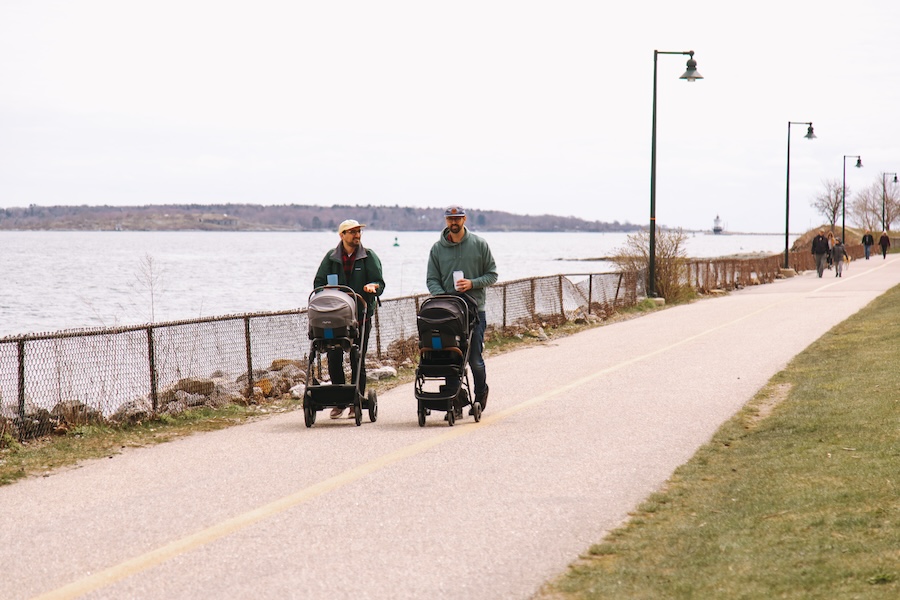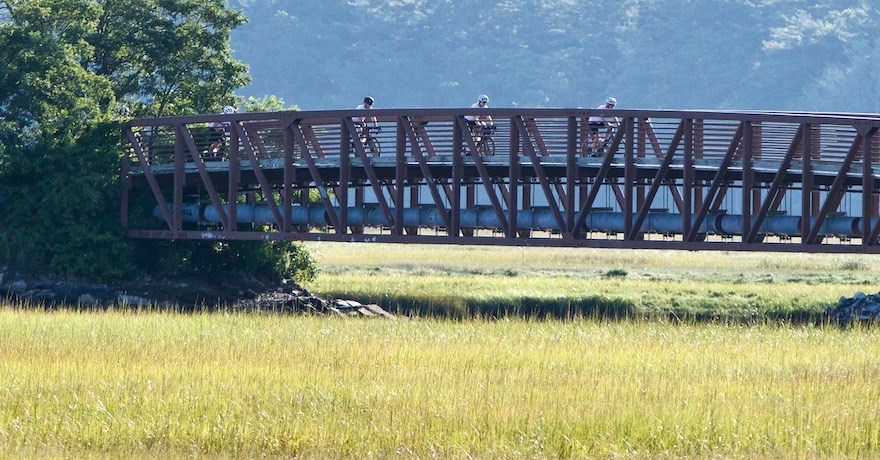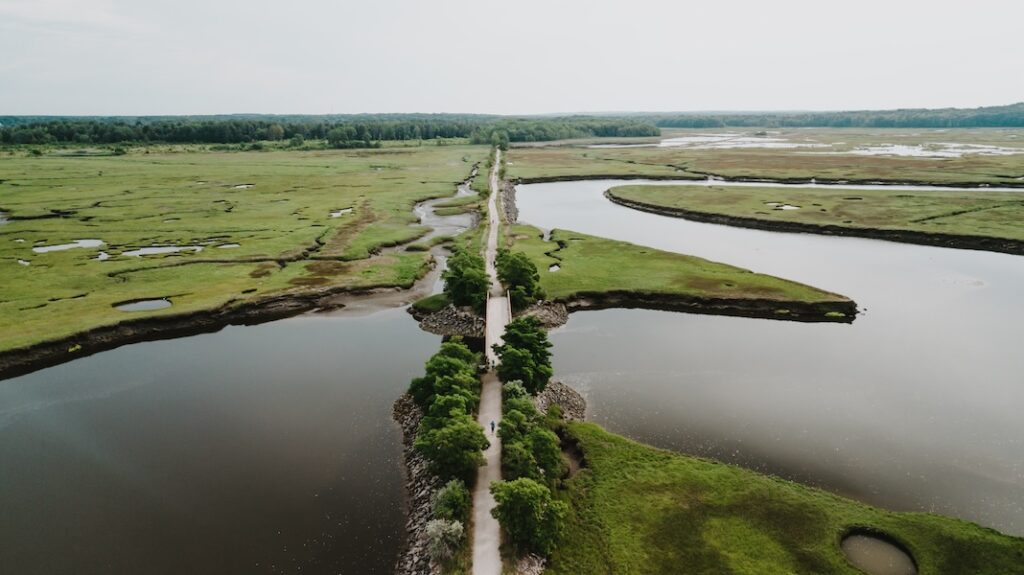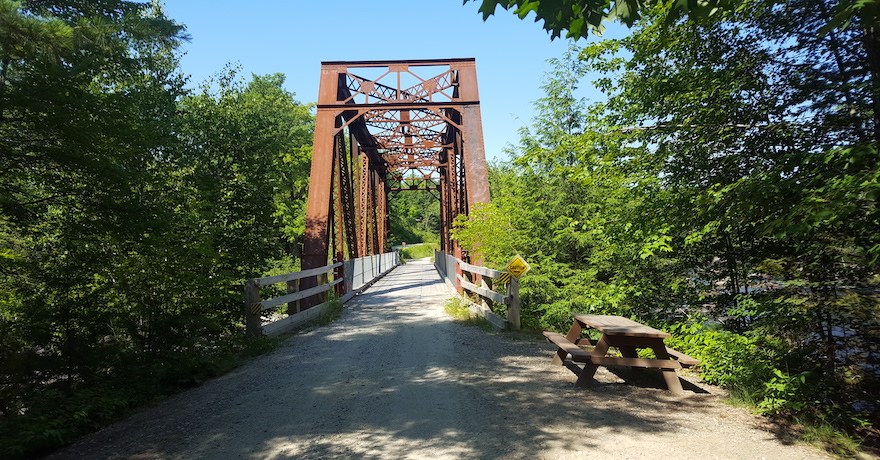Bridging the Gaps: Maine’s Vision for a Statewide Interconnected Trail Network

When Doug Smith moved to Windham, Maine, about 20 years ago, he discovered an overgrown snowmobile trail heading into the woods from his neighborhood. Curious, he followed the path for about half a mile, and much to his surprise, came upon a newly paved recreation trail. Following an old railroad bed, it stretched for 5.5 miles, leading people through the forest to scenic views of the Presumpscot River. It was a part of an incomplete multiuse trail called the Mountain Division Trail.
“I started using it more and more, all seasons of the year, and encountering people I knew,” Smith said. “These trails can actually create a sense of community. It’s far more than just a trail on the ground through the woods and meadows. The trail becomes a place where people meet.”

Today, Smith serves as president of the Mountain Division Alliance, a nonprofit organization working to connect pieces of the trail so that it runs uninterrupted from Portland, Maine’s largest city, 50 miles to the New Hampshire border.
That project, however large, is just a piece of an even greater vision. In the past few years, Maine trail advocates have made huge strides toward building longer rail-trails, and more importantly, connecting them to create a vast network for recreation and off-road transportation.
Coming Together

Connecting trails first requires the connecting of minds. Maine is home to dozens of land trusts and other trail-building organizations, as well as state and federal entities committed to providing trails to the public. While many partnerships among them exist, it wasn’t until the Maine Trails Coalition, or MTC, formed in 2019 that there was a place for all to convene, trade ideas, support each other and dream.
“We all came to it with local projects that we are really jazzed about, and we realized that we have more of an impact working together,” said MTC organizer Jeremy Cluchey. “It’s a rising tide that lifts all boats.”
The loosely organized coalition was spearheaded by leaders of the Merrymeeting Trail, including Cluchey. In 2018, they put out a call for trail builders to gather in Maine’s capital, Augusta. About 70 people showed up, Cluchey recalled. Since then, the group has flourished.
“I’ve honestly been kind of stunned by how much progress we’ve made, and how much we’ve grown,” Cluchey said. “I think there was this deep-seated hunger and support for trails and not a hub for connecting and organizing.”
“What excites me about the coalition is the strength in numbers,” said Paul Drinan, active transportation director for the Bicycle Coalition of Maine. “As we bring our professional skills to the table, we’re a voice for others who may not have the tools or time or connections to do this work.”
Hatching a Plan

A major endeavor of MTC was its Maine Active Transportation Arterials plan, which the group released in May 2022. The ambitious plan calls for the development of an active transportation system that would connect the state’s 25 largest municipalities and over two-thirds of the population.
“We’ve realized that there’s only so much we can do at a local level,” said Cluchey. “Instead of tackling it on a case-by-case basis, we needed to be a part of this statewide strategy.”
A handful of existing pathways form the backbone of this plan: the Eastern Trail, Mountain Division Trail, Casco Bay Trail Loop, Merrymeeting Trail and Down East Sunrise Trail, as well as portions of the East Coast Greenway, an expansive 3,000-mile trail network connecting Maine to Florida.
This spring, the plan was integrated into the first-ever Maine State Active Transportation Plan, released by the Maine Department of Transportation (MaineDOT). It outlines numerous ways the state can improve both on- and off-road routes for active transportation—and that includes turning some of Maine’s 300-plus miles of state-owned, inactive rail corridor into trails.
“Having trails that are walkable or bikeable, it’s super powerful for people’s health, enjoyment and socialization,” said Emily Paskewicz, Northern New England manager for the East Coast Greenway Alliance. “I think opening up that possibility can be a very powerful catalyst for people to shift away from driving and look for other ways they can get around.”

Maine is currently home to nearly 400 miles of rail-trails, broken up into more than 35 separate trails. The goal is to connect many of these, creating an expansive trail system for commuting and long-distance adventurers. This work overlaps with that of the broader New England Rail-Trail Network, which will connect the region’s 1,000 miles of multiuse trail. Over 50% of this vast network is already open, and trail advocates are developing criteria for prioritizing future projects that can continue to build momentum and mobilize support for the effort.
“The mission is to connect the region’s six states via the most imminent connections, those trails that are mostly likely to get done first,” said Tom Sexton, the northeast regional director for Rails to Trails Conservancy, a partner for the New England network. “You can’t build trails in a vacuum. We didn’t do that with our national highway system, and we shouldn’t do that with trails.”

The Maine Way

On a sunny day in early July, Steve Blanc and his daughter, Katie, ushered two horses into a trailer and drove north for a ride along the multiuse Whistle Stop Trail. Connecting the towns of Jay, Wilton and Farmington, the 14-mile rail-trail welcomes a wide range of activities, from ATVing to dog sledding to horseback riding.
“We’re finding more and more that land is either being developed or closed,” Blanc said. “So having places that are publicly available, multiuse and allow equestrians is super critical.”
The gravel Whistle Stop Trail travels through forest and farmland along an old Maine Central Railroad line, providing scenic views of western Maine’s foothills, and crossing streams on historical trestles. In the town of Jay, old granite walls and culverts remain as testaments to quarries that operated there until the turn of the century.
Each trail in Maine has a unique identity, forged by the people who built it and the communities that surround it. On some multiuse trails, only walking and bicycling are allowed, while other trails are open to ATVs, snowmobiles and certain four-legged animals.
Duane Scott, a longtime advocate for safe active transportation and accessibility in Augusta, enjoys walking on the Kennebec River Rail Trail, which runs 6.5 miles along the scenic banks of the Kennebec River, linking the communities of Augusta, Hallowell, Farmingdale and Gardiner. “It’s about choice,” Scott said. “For any individual, it’s about having options for how you get from home to visit your friends or relatives or go shopping.”
Prior to retirement, Scott worked as the statewide multimodal planning director for MaineDOT, and during that time, he traveled the country to learn about active transportation projects being tackled by other states.
“I think it’s good for us to be inspired by other states, but I think it’s always important that in Maine, we do it our own way,” he said. “And that can vary by community and region. The Kennebec River Rail Trail is very much a reflection of the four communities that came together to build it.”
A New Process

Every grand plan needs a process—steps that will be taken to ensure the dream becomes reality. In 2021, Gov. Janet Mills approved a law that gave the MaineDOT commissioner the authority to establish a Rail Use Advisory Council for proposed rail-trail projects. RUAC for short, this council meets and discusses the future use of specific rail corridors in a process that takes nine months and includes many opportunities for public input.
“People want to hear what it will cost and how it will be maintained,” said Jeff McCabe, deputy director of Maine’s Office of Outdoor Recreation. “People are asking important questions.”
To date, RUACs have been established for five separate rail-trail proposals. Three of the councils have completed the process, offering recommendations to the DOT commissioner.
“The rail-trail movement just has exponentially greater momentum and support than it did five or 10 years ago,” Drinan said. “The Maine DOT in particular seems to be a lot more interested in advancing active transportation initiatives.”
Data collected from current rail-trails indicates there is significant demand these projects. A 2022 feasibility study of the Mountain Division Trail included trail usage counts for the two sections of the trail that are currently open. Using this data, they predicted that if 31 continuous miles of this trail were completed, it could see up to 329,000 user trips annually. In addition, an economic impact study of Maine’s Eastern Trail estimated that more than 250,000 people used the 65-mile trail each year.
Lending a Hand


Crickets chirp, stars wink, and hundreds of headlamps dance in the dark as runners follow the Down East Sunrise Trail through the night.
Celebrating its 10th year, the Down East Sunrise Trail Relay is an unusual event. Starting around dinnertime, teams of runners trade off as they trek over 100 miles through eastern Maine, ending at the edge of the ocean. They run all night, through dawn and into the heat of a summer day. Along the way, they stop for breakfast at the clubhouse of the Dennysville Snowmobile and ATV Club. At that point in the race, coffee is a necessity.
“I’m one of the chief cooks and bottle washers,” said Mark Wigley, assistant trail master of the Dennysville Snowmobile and ATV Club and vice president of the Sunrise Trail Coalition Board of Directors. “I’ve been doing it for three years, and it’s a lot of fun.”
Wigley isn’t the only ATV rider in the area that views volunteer work as fun. His club, in cooperation with the state, is continually working to maintain and improve the 87-mile multiuse Sunrise Trail. After recent storms, they helped clean up over 400 trees that fell across the route.
“There are a lot of retirees that are members, and when our club president puts out the call that he needs help, they show up,” he said, noting that the key to a successful volunteer workday is access to the right heavy equipment and providing plenty of hamburgers and hotdogs.
Lavinia Clarke, who works as a project coordinator for the Sunrise Trail Coalition and collaborates closely with the area’s ATV clubs, agrees with Wigley’s sentiments. “I’ve just been struck by how many people show up to do completely unpaid labor for the benefit of this trail they love,” she said.
Finding the Funds

Trail advocates are confident that the long-term economic benefits of the Maine Active Arterials Plan will be significant to justify the $160 million estimated cost of its priority projects. For example, a recent study of Maine’s Eastern Trail alone, which extends from South Portland to the state border in Kittery, estimates a total annual economic impact of $44.6 million.
“We know that there is a truly positive impact from trails, particularly those that connect community to community,” said Carolann Ouellette, Maine’s director of tourism, film and outdoor recreation.
Yet, partners also affirm that the value of these trails can’t entirely be understood in dollars.
“There are so many studies that support, even more than the economic benefit of it, that it’s good for people’s health and offers options for clean transportation,” Ouellette said. “Communities that invest in that type of infrastructure have a greater chance at attracting new residents and businesses.”

This spring, both the Maine House and Senate overwhelmingly approved a $30 million bond to invest in trails across the state—and residents will vote on the bond this fall. Part of those funds could go towards designing and maintaining rail-trails, but the key is to secure federal funding, of which there are many sources, according to Sexton.
“There were just six votes against it [in the House of Representatives],” Cluchey said. “That kind of bipartisanship is nonexistent in Augusta or anywhere else right now. It’s really telling what a unifying force trails are in the state.”
Of the many rail-trail projects currently being considered, the Mountain Division Trail is a top priority and has already gone through the RUAC process. Two sections of the trail have long been completed. Now it’s time to bridge the gaps.
“That’s when the magic happens,” Smith said.
Spotlight on Maine’s Eastern Promenade Trail

In the morning during fair weather, it’s not uncommon to see several exercise groups scattered along Maine’s Eastern Promenade Trail, a pathway that follows an old rail corridor along the Portland waterfront.
“We watch as the light changes,” said Kim Simmons, who attends yoga on a grassy hill beside the trail. “It’s kind of magical, right there on the ocean, with the breeze.”
A Portland resident, Simmons visits the trail weekly to walk, bike and attend classes. She’s noticed that a wide diversity of people enjoy the route. “There are people pushing strollers. There are immigrant families. There are different languages being spoken,” she noted. “There’s a sense that it’s a shared community space. It feels accessible and welcoming.”
The 2.1-mile trail, which is maintained by the City of Portland and included in the proposed Maine Active Transportation Arterials network, features parallel paved and gravel paths and connects to other city trails. It also visits East End Beach, where you can swim or rent kayaks and launch them from the public boat launch.
Rebecca Murdoch, who lives just over a mile from the trail, visits often to walk her husky, Knox. “It takes you outside of the busyness of the city,” she said. “It feels peaceful to me.”
This article was originally published in the Fall 2024 issue of Rails to Trails magazine and has been reposted here in an edited format. Subscribe to read more articles about remarkable trails while also supporting our work.


Donate
Everyone deserves access to safe ways to walk, bike, and be active outdoors.
